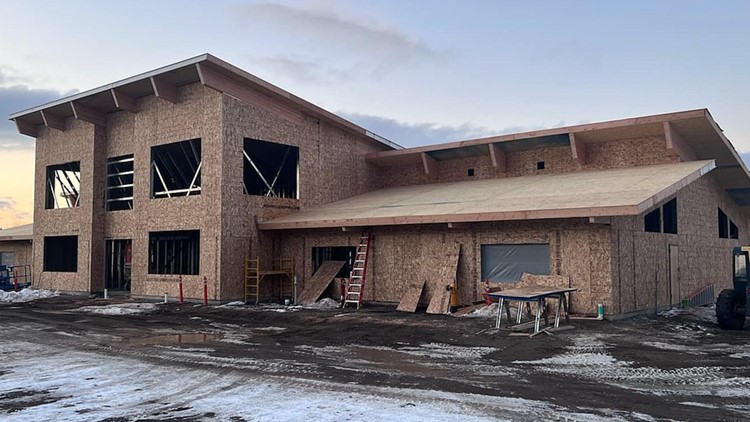COEUR D'ALENE, Idaho — Chris Bjurstrom is tentatively celebrating some wins as owner of ABCD Daycare.
“For the first time since COVID-19 started, we’re at full staff and full capacity,” Bjurstrom said. “But I’m afraid that in the next breath someone may quit and go somewhere else.”
It’s been a series of challenges for her and other local child care centers, reports our partners from the Coeur d'Alene Press.
Bjurstrom decided to sell her Coeur d’Alene branch of ABCD to better manage the Hayden location and the challenges of 2020.
And she’s not alone, with 13 other child care centers in Coeur d’Alene closing since 2019, said Kelley Setters, deputy clerk for the city of Coeur d’Alene. In that time, only four daycare centers have opened. With the closure of ABCD Daycare Coeur d’Alene, Kootenai County lost its capacity for 100 children.
Now, staffing the Hayden ABCD center has been a huge challenge for Bjurstrom, as wages have doubled since COVID-19 hit.
“The grant money has been major,” Bjurstrom said. “It's been a struggle, but it would've been 10 times harder without that.”
Federally funded state grants help childcare centers stay open, or supplement wages for childcare workers. But even with wage grants making payroll manageable, the demand for child care continues to outpace the spaces Bjurstrom has available for children.
“I have a waitlist a mile long,” said Erika Starkey, owner of Kinder Prep Learning Center in Post Falls. “Child care is few and far between in this area.”
Starkey is in the process of building a new childcare center to respond to shortages in childcare exposed by COVID-19. Kootenai County is seeing a huge demand for access to child care, Starkey said, and the new center will add 190 new openings for children 18 months to 5 years old.
“Ever since COVID hit, it's been a nightmare trying to get any kind of daycare for my eldest daughter,” said Lacey Dorn, a mother in Post Falls. “The price has doubled in two years. I don’t know how people are doing it. It forces parents down to one income, and I don’t know how anyone can do that. At $1,300 a month, you’re paying a mortgage for daycare.”
Parents tell child care center owners like Starkey and Bjurstrom they’re on every local waiting list — and they say every child care center has a waiting list.
Some childcare facilities see as many as five times the amount of applicants as they have openings each season.
“We are turning people away,” Bjurstrom said. “We are at full capacity, and it breaks my heart to turn people away.”
North Idaho College is helping to meet some demand for staffing, with the largest early childhood development class they’ve ever had. Of those nearly 80 students, most already participate in a work-study program providing daycare in the community, said Kathleen Miller Green, professor of child development at NIC.
“Nationally, the childcare workforce turns over by 50% every year,” Miller Green said. “It’s low pay, long hours, and if you do it right, it’s hard work. A lot of programs can’t offer benefits or insurance.”
Employees will often advance out of early child care and move into better paying jobs, Miller Green said.
“It has both a labor supply and a labor demand constraint,” said Sam Wolkenhauer, regional economist for the Idaho Department of Labor. “Shortage of child care, or when child care is very expensive, limits the labor supply because it keeps parents from working. But it also is an industry that’s very hard to staff.”
Access to child care has a direct correlation to participation in the labor market, Wolkenhauer said.
“We are definitely facing a situation where shortage of workers is one of the biggest economic issues,” he said.
The ability of workers to enter the job market often hinges on access to affordable child care.
“Child care is an industry that cannot become more efficient,” Wolkenhauer said. “Because of the legal ratios and constraints set on daycare standards, the only way for a daycare to serve more kids is to have more space and more workers.”
Child care centers have legal limits on the amount of children any one staffer can take care of, and how much space that requires. Those constraints skew the natural supply-and-demand relationship in the industry by capping supply.
“Part of the problem with child care, and not having enough of it, is that it doesn’t pay as well as the school districts,” Wolkenhauer said. “Median wages for early child care workers are less than half of the median wages of elementary schools.”
Childcare facilities posted 1,200 job openings for child care workers across Idaho in 2022, Wolkenhauer said.
That translates to a current shortage of 20,000 childcare openings across the state, where 74,000 childcare positions are needed, said Keri Cederquist, community impact director at United Way of North Idaho.
United Way is working in collaboration with the local private sector and childcare providers in an attempt to find solutions to the impending financial cliff, when grant money is expected to end June 30, 2023.
“We’re working statewide to try to elevate the profession,” Cederquist said. “Long-term, there’s not a lot of people entering the field as a career because the pay is so low and it’s a really demanding field. United Way is designed to empower locals to improve the systems of early care and education. Our long-range strategy is increasing business and community engagement to be a partner in solving this really big challenge.”
United Way supports access to child care through a state pilot program for a workforce development council, the North Idaho Early Learning Collaborative. The goal of the collaborative is to expand access to quality, affordable child care to working families in Kootenai and Bonner counties.
“Child care access is infrastructure and without it, people can’t work,” said “State reimbursement for child care just covers the bare minimum and not enough to provide a quality program.”
The council administers grant funds to connect local businesses with local childcare providers and to foster collaboration to provide childcare seats. Those collaborations can then draw reimbursement funds from grants.
“It’s clear given the research nationally that child care cannot sustain itself; there’s too much of a gap between what people can afford and what child care costs,” Cederquist said.
So with higher wages, higher demand and higher costs, prices wouldn’t be sustainable without access to grants.
Parents can also apply for scholarships, federal grants or aid to make child care more accessible, Cederquist said, but often those thresholds are lower than federal programs like the Supplemental Nutrition Assistance Program (SNAP), and parents make too much to qualify, but not enough to cover child care.
Starkey guides people to United Way scholarship applications on her website and encourages families to find access to resources.
“It always trickles down where every time something gets increased it’s got to come from somewhere,” Bjurstrom said. “The middle class are feeling it now.”
She’s tried not to raise prices, despite seeing costs increase on everything from food, janitorial supplies and school supplies to utilities and property taxes.
“We’ve always taken pride in providing quality care for all of these kiddos and their families and it’s getting harder and harder,” Bjurstrom said.
If Bjurstrom and Starkey are forced to raise prices because of continued rising costs, they’ll price out much of the middle class market, further straining low- and middle-income families.
“Grant money supplements wages and when that runs out, it comes out of our pocket,” Bjurstrom said. “We’ll do everything in our power not to make further layoffs.”
If supply drops further in childcare access, the labor market will be further strained.
“Often, we have parents coming in to enroll their children who have adapted their home life to revolve around working from home and having their children there at the same time,” Starkey said. “The most frequent feedback I hear from families is the challenge of being productive when their children are there and they don’t have anyone to entertain them or provide undivided attention.”
Bjurstrom has cleared some of the early pandemic hurdles in her business, but now she is seeing different challenges with children. She’s seen increased instances of behavioral issues, and more kids with anxiety or difficulties with speech development.
“It used to be that you would have three to five kiddos throughout the school that were more difficult, and now we’re looking at that in every class,” Bjurstrom said. Those pressures are then felt by her staff, “And if these guys can go flip a burger, why take on the stress?”
The Coeur d'Alene Press is a KREM 2 news partner. For more from our partners, click here.
DOWNLOAD THE KREM SMARTPHONE APP
DOWNLOAD FOR IPHONE HERE | DOWNLOAD FOR ANDROID HERE
HOW TO ADD THE KREM+ APP TO YOUR STREAMING DEVICE
ROKU: Add the channel from the ROKU store or by searching for KREM in the Channel Store.
Fire TV: Search for "KREM" to find the free app to add to your account. Another option for Fire TV is to have the app delivered directly to your Fire TV through Amazon.
To report a typo or grammatical error, please email webspokane@krem.com.



